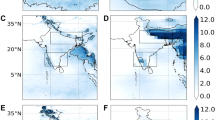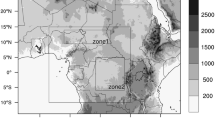Abstract
The climatic effects of aerosols on the precipitation over the Amazon during the dry to wet transition period have been investigated using an atmospheric general circulation model, NCEP/AGCM, and the aerosol climatology data. We found increased instability during the dry season and delayed wet season onset with aerosols included in the model simulation, leading to the delay of the maximum precipitation over the Amazon by about half a month. In particular, our GCM simulations show that surface solar flux is reduced in the Amazon due to the absorption and scattering of the solar radiation by aerosols, leading to decreased surface temperature. Reduced surface solar flux is balanced by decreases in both surface sensible heat and latent heat fluxes. During the wet season, the subtropical system over the Amazon has a shallower convection. With the inclusion of aerosols in the simulation, precipitation in the rainy season over the Amazon decreases in the major rainfall band, which partially corrects the overestimate of the simulated precipitation in that region. The reduced surface temperature by aerosols is also coupled with a warming in the middle troposphere, leading to increased atmosphere stability and moisture divergence over the Amazon. However, during the dry season when the convective system is stronger over the Amazon, rainfall increases in that region due to the warming of the air over the upper troposphere produced by biomass burning aerosols, which produces an anomalous upward motion and a convergence of moisture flux over the Amazon and draws the moisture and precipitation further inland. Therefore, aerosol effects on precipitation depend on the large-scale atmospheric stability, resulting in their different roles over the Amazon during the dry and wet seasons.









Similar content being viewed by others
References
Boisier JP, Ciais P, Ducharne A, Guibmerteau M (2015) Projected strengthening of Amazonian dry season by constrained climate model simulations. Nat Clim Change 5:656–660. doi:10.1038/nclimate2658
Butt N, de Oliveira PA, Costa MH (2011) Evidence that deforestation affects the onset of the rainy season in Rondonia, Brazil. J Geophys Res Atmos 116(D11):D11120. doi:10.1029/2010jd015174
Chou MD, Suarez MJ, Ho CH, Yan MMH, Lee KT (1998) Parameterizations for cloud overlapping and shortwave single-scattering properties for use in general circulation and cloud ensemble models. J Clim 11:202–214
Coakley JA, Cess RD, Yurevich FB (1983) The effect of tropospheric aerosols on the earth’s radiation budget: a parameterization for climate models. J Atmos Sci 42:1408–1429
Cox PM, Harris PP, Huntingford C, Betts RA, Collins M, Jones CD, Jupp TE, Marengo JA, Nobre CA (2008) Increasing risk of Amazonian drought due to decreasing aerosol pollution. Nature 453(7192):212–215
Fels SB, Schwarzkopf MD (1975) The simplified exchange approximation: a new method for radiative transfer calculations. J Atmos Sci 32:1475–1488
Fu R, Li W (2004) The influence of the land surface on the transition from dry to wet season in Amazonia. Theor Appl Climatol 78:97–110. doi:10.1007/s00704-004-0046-7
Fu R, Dickinson RE, Chen M, Wang H (2001) How do tropical sea surface temperatures influence the seasonal distribution of precipitation in the equatorial Amazon? J Clim 14(20):4003–4026. doi:10.1175/1520-0442(2001)014<4003:hdtsst>2.0.co;2
Goncalves WA, Machado LAT, Kirstetter PE (2015) Influence of biomass aerosol on precipitation over the Central Amazon: an observational study. Atmos Chem Phys 15:6789–6800. doi:10.5194/acp-15-6789-2015
Greco S, Swap R, Garstang M, Ulanski S, Shipham M, Harriss RC, Talbot R, Andreae MO, Artaxo P (1990) Rainfall and surface kinematic conditions over central Amazonia during ABLE 2B. J Geophys Res Atmos 95(D10):17001–17014. doi:10.1029/JD095iD10p17001
Gu Y, Liou KN, Xue Y, Mechoso CR, Li W, Luo Y (2006) Climatic effects of different aerosol types in China simulated by the UCLA general circulation model. J Geophys Res 111:D15201. doi:10.1029/2005JD006312
Gu Y, Liou KN, Chen W, Liao H (2010) Direct climate effect of black carbon in China and its impact on dust storm. J Geophys Res 115:D00K14. doi:10.1029/2009JD013427
Gu Y, Liou KN, Jiang JH, Su H, Liu X (2012) Dust aerosol impact on North Africa climate: a GCM investigation of aerosol-cloud-radiation interactions using A-Train satellite data. Atmos Chem Phys 12:1667–1679. doi:10.5194/acp-12-1667-2012
Gu Y, Xue Y, De Sales F, Liou KN (2016) A GCM investigation of dust aerosol impact on the regional climate of North Africa and South/East Asia. Clim Dyn 46:2353–2370. doi:10.1007/s00382-015-2706-y
Hansen J, Sato M, Ruedy R (1997) Radiative forcing and climate response. J Geophys Res 102:6831–6864
Hess M, Koepke P, Schult I (1998) Optical properties of aerosols and clouds: the software package OPAC. Bull Am Meteorol Soc 79:831–844
Heymsfield AJ, McFarquhar GM (1996) High albedos of cirrus in the tropical Pacific warm pool. J Atmos Sci 53:2424–2451
Hou YT, Campana KA, Yang SK (1996) Shortwave radiation calculations in the NCEP’s global model. In: International radiation symposium, IRS-96, August 19–24, Fairbanks, AL
Hou YT, Moorthi S, Campana KA (2002) Parameterization of solar radiation transfer in the NCEP models. NCEP Office Note, 441. http://www.emc.ncep.noaa.gov/officenotes/FullTOC.html#2000
Jiang JH, Su H, Schoeberl M, Massie ST, Colarco P, Platnick S, Livesey N (2008) Clean and polluted clouds: relationships among pollution, ice cloud and precipitation in South America. Geophys Res Lett 35:L14804. doi:10.1029/2008GL034631
Jiang JH, Su H, Zhai C, Massie ST, Schoeberl MR, Colarco PR, Platnick S, Gu Y, Liou KN (2011) Influence of convection and aerosol pollution on ice cloud particle effective radius. Atmos Chem Phys 11:457–463. doi:10.5194/acp-11-457-2011
Johnson BT, Shine K, Forster P (2004) The semi-direct aerosol effect: impact of absorbing aerosols on marine stratocumulus. Q J R Meteorol Soc 130:1407–1422
Joseph JH, Wiscombe WJ, Weinman JA (1976) The delta-Eddington approximation for radiative flux transfer. J Atmos Sci 33:2452–2459
Kanamitsu M, Ebisuzaki W, Woollen J, Yang SK, Hnilo JJ, Fiorino M, Potter GL (2002) NCEP-DOE AMIP-II Reanalysis (R-2). Bull Am Meteorol Soc 83:1631–1643
Kiehl JT, Hack JJ, Bonan GB, Boville BA, Williamson DL, Rasch PJ (1998) The national center for atmospheric research community climate model: CCM3. J Clim 11:1131–1149
Lau KM, Kim MK, Kim KM (2006) Asian summer monsoon anomalies induced by aerosol direct forcing: the role of the Tibetan Plateau. Clim Dyn 26:855–864. doi:10.1007/s00382-006-0114-z
Lenters JD, Cook KH (1997) On the origin of the Bolivian high and related circulation features of the South American climate. J Atmos Sci 54:22
Lewis SL, Brando PM, Phillips OL, van der Heijden GMF, Nepstad D (2011) The 2010 Amazon drought. Science 331:6017. doi:10.1126/science.1200807
Li W, Fu R (2004) Transition of the large-scale atmospheric and land surface conditions from the dry to the wet season over Amazonia as diagnosed by the ECMWF re-analysis. J Clim 17:2637–2651
Liebmann B, Marengo JA (2001) Interannual variability of the rainy season and rainfall in the Brazilian Amazon Basin. J Clim 14:4308–4318
Machado LAT, Rossow WB, Guedes RL, Walker AW (1998) Life cycle variations of mesoscale convective systems over the Americas. Mon Weather Rev 126(6):1630–1654. doi:10.1175/1520-0493(1998)126<1630:lcvomc>2.0.co;2
Marengo JA, Nobre CA, Tomasella J, Oyama MD, Sampaio de Oliveira G, de Oliveira R, Camargo H, Alves LM, Brown IF (2008) The drought of Amazonia in 2005. J Clim 21(3):495–516. doi:10.1175/2007jcli1600.1
Marengo JA, Tomasella J, Alves LM, Soares WR, Rodriguez DA (2011) The drought of 2010 in the context of historical droughts in the Amazon region. Geophys Res Lett. doi:10.1029/2011gl047436
Martin ST, Andreae MO, Artaxo P, Baumgardner D, Chen Q, Goldstein AH, Guenther A, Heald CL, Mayol Bracero OL, McMurry PH, Pauliquevis T, Poschl U, Prather KA, Roberts GC, Saleska SR, Silva Dias MA, Spracklen DV, Swietlicki E, Trebs I (2010) Sources and proprieties of Amazonian aerosol particles. Rev Geophys 48(1–42):RG000280. doi:10.1029/2008RG000280
Martins JA, Silva Dias MAF, Gonçalves FLT (2009) Impact of biomass burning aerosols on precipitation in the Amazon: a modeling case study. J Geophys Res 114:D02207. doi:10.1029/2007JD009587
Menon S, Hansen J, Nazarenko L, Luo Y (2002) Climate effects of black carbon aerosols in China and India. Science 297:2250–2253
Miller RL, Tegen I (1998) Climate response to soil dust aerosols. J Clim 11:3247–3267
Pan HL, Wu WS (1995) Implementing a mass flux convective parameterization package for the NMC medium-range forecast model. NMC Off Note 409, pp 40
Petersen WA, Nesbitt SW, Blakeslee RJ, Cifelli R, Hein P, Rutledge SA (2002) TRMM observations of intraseasonal variability in convective regimes over the Amazon. J Clim 15(11):1278–1294. doi:10.1175/1520--0442(2002)015<1278:tooivi>2.0.co;2
Petersen WA, Fu R, Chen M, Blakeslee R (2006) Intraseasonal forcing of convective and lightning activity in the southern Amazon as a function of cross-equatorial flow. J Clim 19:3180–3196
Rickenbach TM (2002) Modulation of convection in the southwestern Amazon basin by extratropical stationary fronts. J Geophys Res. doi:10.1029/2000jd000263
Schwarzkopf MD, Fels SB (1991) The simplified exchange method revisited: an accurate, rapid method for computation of infrared cooling rates and fluxes. J Geophys Res 96(D5):9075–9096
Silva Dias MAF (2002) Cloud and rain processes in a biosphere–atmosphere interaction context in the Amazon Region. J Geophys Res. doi:10.1029/2001jd000335
Sundqvist H, Berge E, Kristjansson JE (1989) Condensation and cloud studies with mesoscale numerical weather prediction model. Mon Weather Rev 117:1641–1757
Xie P, Arkin PA (1997) Global precipitation: a 17-year monthly analysis based on gauge observations, satellite estimates and numerical model outputs. Bull Am Meteorol Soc 78:2539–2558
Xu KM, Randall DA (1996) A semi-empirical cloudiness parameterization for use in climate models. J Atmos Sci 53:3084–3102
Xue Y, Sellers PJ, Kinter JL III, Shukla J (1991) A simplified biosphere model for global climate studies. J Clim 4:345–364
Xue Y, Juang HMH, Li WP, Prince S, DeFries R, Jiao Y, Vasic R (2004) Role pf land surface processes in monsoon development: East Asia and West Africa. J Geophys Res 109:D03105. doi:10.1029/2003JD003556
Zeng N, Yoon J-H, Marengo JA, Subramaniam A, Nobre CA, Mariotti A, Neelin JD (2008) Causes and impacts of the 2005 Amazon drought. Environ Res Lett 3(1):014002
Zhan X, Xue Y, Collatz GJ (2003) An analytical approach for estimating CO2 and heat fluxes over the Amazonian region. Ecol Model 162:97–117
Zhao QY, Carr FH (1997) A prognostic cloud scheme for operational NWP models. Mon Weather Rev 125:1931–1953
Acknowledgments
The authors appreciate the funding support by the GoAmazon project Award Number DE-SC0011117, NASA ROSES14-ACMAP programs, and NSF Grants AGS-1419526. Author J.H.J. also acknowledge the support from the NASA-sponsored Jet Propulsion Laboratory, California Institute of Technology.
Author information
Authors and Affiliations
Corresponding author
Rights and permissions
About this article
Cite this article
Gu, Y., Liou, K.N., Jiang, J.H. et al. A GCM investigation of impact of aerosols on the precipitation in Amazon during the dry to wet transition. Clim Dyn 48, 2393–2404 (2017). https://doi.org/10.1007/s00382-016-3211-7
Received:
Accepted:
Published:
Issue Date:
DOI: https://doi.org/10.1007/s00382-016-3211-7




